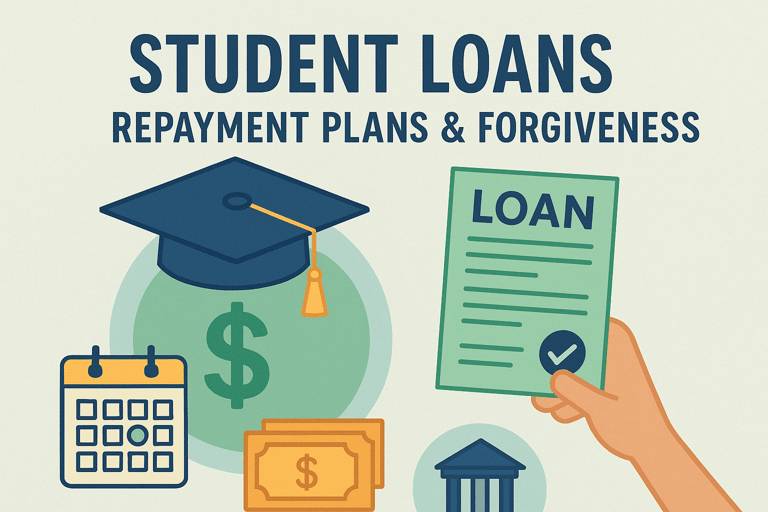Student Loans in 2025 – Repayment Plans & Forgiveness Updates


Facing Student Debt in 2025
If you’re one of the millions of Americans with student loans, you know it can feel overwhelming. Tuition keeps rising, living expenses are high, and the job market is competitive. But don’t worry—you’re not alone. Understanding how student loans work and the options available in 2025 can help you take control of your finances and reduce stress.
This guide will walk you through federal and private loans, repayment plans, forgiveness programs, and practical strategies to manage your debt efficiently—without making your life miserable.
What Types of Student Loans Are Out There?
In the US, student loans are mostly divided into federal or private. Federal loans are funded by the government and usually have lower interest rates and flexible repayment options. These include Direct Subsidized Loans, Direct Unsubsidized Loans, and PLUS loans. Subsidized loans are based on financial need, and the government pays interest while students are in school. Unsubsidized loans accrue interest immediately, and PLUS loans are available to graduate students or parents.
Private loans, offered by banks, credit unions, and online lenders, generally have higher interest rates and fewer repayment options. A good credit score or a co-signer is usually required. While they can help cover extra costs, they lack federal protections.
Tip: Always max out federal loans before considering private loans.
Repayment Plans That Fit Your Life
Not every repayment plan is the same. Choosing the right one can save you money and reduce stress.
Standard Repayment: Fixed payments over 10 years. Simple and predictable.
Graduated Repayment: Starts lower, increases every 2 years. Works if you expect your income to rise.
Extended Repayment: For large balances, payments last up to 25 years.
Income-Driven Repayment (IDR): Payments are a percentage of your discretionary income. Remaining debt may be forgiven after 20–25 years of qualifying payments.
Example: Imagine Asha earns $40,000 a year and is on an IDR plan. Her monthly payment might be around $150. If she sticks to it for 20 years, some of her debt could be forgiven, saving her thousands.
Mini Tip: IDR plans are great for managing monthly cash flow but may increase total interest over time. Always weigh your options.
Student Loan Forgiveness Programs in 2025
Forgiveness programs can make a huge difference, especially if you’re in public service or teaching.
Public Service Loan Forgiveness (PSLF): If you work full-time for a government or non-profit organization, your remaining federal debt may be forgiven after 10 years of qualifying payments.
Teacher Loan Forgiveness: Teachers in low-income schools can have up to $17,500 forgiven after five years.
Income-Driven Forgiveness: Any remaining balance after 20–25 years on an IDR plan may be forgiven.
2025 Updates: Temporary federal relief measures have been introduced, including interest adjustments and updated guidance on eligibility verification.
Example: John works for a nonprofit and has $50,000 in federal loans. By staying on an IDR plan and making consistent payments, he could see a significant portion of his debt forgiven after 20 years.
Smart Strategies to Manage Your Loans
Even with great repayment options, it’s smart to actively manage your debt.
Pay a Little Extra: Even $50 extra per month can shorten your repayment period and save on interest.
Consolidate for Simplicity: Federal loan consolidation combines multiple loans into one payment. It doesn’t always lower interest but makes life simpler.
Automate Payments: Autopay prevents late fees and may reduce interest slightly.
Avoid Risky Private Loan Moves: Variable rates can increase unexpectedly. Refinance only if you understand the trade-offs.
Mini Tip: Track your loans with apps like Mint or YNAB. Seeing your progress can motivate you to pay off debt faster.
How Interest Rates and Inflation Affect You
Interest rates for federal loans in 2025 are:
Undergraduate Direct Loans: 5.5%
Graduate Direct Loans: 6.5%
PLUS Loans: 7%
Private loans can be higher and variable. Inflation reduces the real value of money over time, but paying off high-interest debt first is always a smart move.
Tools & Resources for Borrowers
StudentAid.gov: Apply, manage, and track federal loans.
Mint / YNAB: Budgeting and tracking expenses.
Credible / LendKey: Compare private refinancing options.
Tip: Set reminders for payments and consult a financial advisor if your situation is complex.
FAQs
Q. Can I refinance my student loans?
A. Yes, but refinancing federal loans with a private lender removes federal protections like forgiveness or IDR options.
Q. How do I qualify for PSLF?
A. Work full-time for a qualifying employer, have Direct Loans, and make 120 qualifying payments under an IDR plan.
Q. Is it better to pay extra or stay on IDR?
A. Extra payments reduce interest and shorten repayment time, while IDR lowers monthly payments and can lead to forgiveness.
Q. Do private loans qualify for forgiveness?
A. No, only federal loans are eligible.
Q. Can student loans affect my credit score?
A. Yes, late or missed payments hurt your score. On-time payments can help build credit.
Conclusion: Take Control of Your Student Debt
Student loans don’t have to control your life. By understanding repayment plans, leveraging forgiveness programs, making extra payments when possible, and using financial tools, you can reduce stress and save money. Staying informed and proactive ensures you’re not just surviving your student debt—you’re actively managing it and moving toward a financially secure future.

